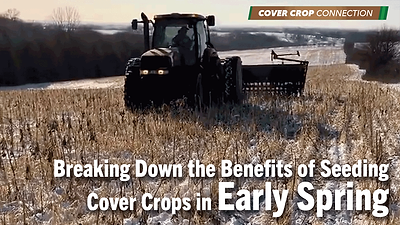By Bill Johnson, Travis Leglieter, Botany and Plant Pathologists
Soil residual herbicides can remain active in the soil for anywhere from weeks to months after application. The length of time a residual herbicide remains biologically active in the soil is influenced by soil type, soil pH, organic matter, rainfall and temperature. Since these factors will vary from field to field, definitive time intervals of residual herbicide activity can be difficult to predict.
A significant challenge has risen because use of residual herbicides in our corn and soybean production systems may interfere with establishment of fall-seeded cover crops. An unfortunate coincidence is that many of the crops being used for cover crops were not evaluated for herbicide carryover when field research was being conducted for support of the EPA label of the respective herbicide. As a result, data are lacking regarding rotational intervals for establishment of many cover crop species.
Over the last couple of growing seasons we have established experiments designed to evaluate the impact of commonly used residual herbicides on the establishment of many cover crop species. In addition, our colleagues in adjacent states have conducted similar research and we feel like we have a better handle on this topic now than we did 2 or 3 years ago. As was mentioned above, predicting herbicide persistence is complicated because so many different factors can influence herbicide dissipation in the soil.
As a general rule, residual herbicides that have activity on grass weeds can interfere with the establishment of some grass cover crop species, especially the smaller seeded ryegrass species. Residual herbicides from the group 2 (ALS), group 5 (triazine), group 14 (PPO), or group 27 (bleacher) can interfere with the establishment of some of the broad-leaf cover crop species.
More specifically we have learned the following:
Corn herbicides
- Pyroxasulfone (Zidua) and metolachlor (Dual, etc.) can hinder ryegrass establishment.
- Atrazine or simonize at less than 1 pound will be problematic for legumes and mustards unless there is a lot of rain. Less than 3/4 pound per acre may allow for most legume cover crops, mustards and annual ryegrass. Atrazine at less than 1 pound per acre can allow cereal grain establishment.
- Mesotrione (Callisto, Lumax, Lexar, etc.), flumetsulam (Python) and clopyralid (Stinger, Hornet, SureStart) can be problematic for legumes and mustards like canola and forage radish.
Soybean herbicides
- Chlorimuron (Classic, Canopy, Cloak, etc.) imazethapyr (Pursuit) and fomesafen (Reflex, etc.) could be a problem for fall-seeded legume or mustard covers, including radish. However, establishment of cereal grains should be OK.
This summarizes our current knowledge on establishment of cover crops following the use of residual herbicides. The final two things to mention is that if you have questions about specific situations, one way to address the residual herbicide left in a field is to do a bioassay. Simply collect soil from the area you would like to seed the cover crop into and an area with a similar soil type, but no herbicide residue, and plant seed from the cover crop you would like to use. Observe growth for 3 weeks and if the plants look the same in the untreated and treated soil, you should be safe to plant to desired crop.
Another consideration, if you do not have time to do a bioassay, is to plant a cover crop mixture. Cover crop establishment may be more reliable when mixtures of grass and broadleaf species are purchased and planted. Residual herbicides may interfere with establishment of some species in the mix, but have no effect on other species. The use of mixtures may allow one more protection from complete failure due to excessive residues in the soil. It would be important, however, to be sure that at least one or two of the species in the mixture is tolerant to the herbicides used in a specific field.



